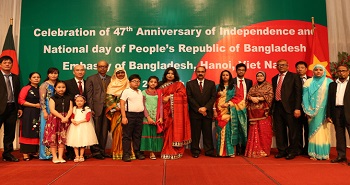-

Bangladesh targets $1b trade ties with Vietnam
-

VIETNAM COFFEE EXPORTS UNDER THE TOP 2 OF THE WORLD
-

Rice Exports by Country
-
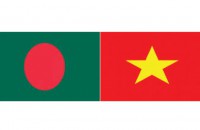
Relations between Bangladesh and Vietnam
-
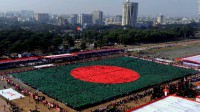
Bangladesh Economic Outlook 2019: A resilient economy in need of sound policy LIGHTCASTLE ANALYTICS WING
-
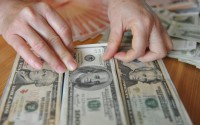
Bangladesh Economy Continues Robust Growth with Rising Exports and Remittances
-

Vietnam beats us in RMG for last 5 months in 2019
-
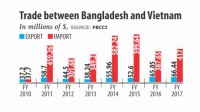
Bangladesh to seek more Vietnamese investment
Agri-food and horticulture in Vietnam
Agriculture is one of the most important economic sectors in Vietnam. Besides production for an increasing domestic demand, Vietnam is a major exporter of agricultural products. Business opportunities are abundant at all levels of the value chain, as production levels continue to improve through the application of intensive farming and advanced technologies. Dominant crops include coffee, rubber, cashew and rice. In more recent years, aquaculture and fruit production have grown substantially and are export-oriented as well. Surging domestic consumption combined with increasing demand for high-value products have also pushed imports of agricultural products into Vietnam. Meat and meat products enjoy the highest growth figures, followed by rubber, animal feed and feed grain, sugar and cotton. The Netherlands and Vietnam are longstanding cooperation partners when it comes to agriculture.
.jpg)
With its significant contribution to gross domestic product (20%), agriculture will continue to play a considerable role in Vietnam’s transition to a market-based economy. Vietnam’s strength in agriculture output is built upon a large rural base (66% of the population) where farm and agri-business labour accounts for 70% of the workforce. Besides production to satisfy (increasing) domestic demand, Vietnam is also playing its part on the agricultural import and export markets. Alongside the growing production value of the agricultural products mentioned earlier, Vietnam has significantly increased productivity in rice-growing over the past 15 years, and it has become the largest rice exporter in the world. As purchasing power and consumer awareness are increasing, the domestic market becomes more and more interesting.
Vietnam is characterised by a certain extent of geographical specialisation with particular crops concentrated in specific parts of the country such as:
- Aquaculture in the Mekong River Delta
- Rice in the Mekong River Delta and Red River Delta
- Coffee in the Central Highlands
- Tea in the Northeast and Northwest
- Rubber in the South
- Fruit in the Mekong River Delta
- Cocoa in the Central Highlands, Mekong Delta
- Spices in the Central Highlands
- Dairy in the Mekong Delta, the Northwest
- Pork in the South
- Vegetables in Lam Dong and the Red River Delta
- Flowers in Lam Dong, the North
Agricultural cooperation between the Netherlands and Vietnam
The Netherlands and Vietnam have a long-lasting trade relationship, which dates back to the 17th century when silk, sugar, wool, and spices were the main trading products. Almost 400 years later, the bilateral trade now covers hundreds of different products. Currently, the Dutch committed overall investment in Vietnam is worth about USD 2.4 billion. The Netherlands ranks as the 8th largest investor in the agricultural sector of Vietnam, with 9 projects that have a total registered capital of over USD 180 million. Exports to the Netherlands cover agricultural products such as seafood, coffee, nuts and spices. Agriculture remains a promising sector and both countries show strong commitment to cooperating and creating a win-win situation.
The Dutch government has an active policy of promoting trade and investment in agriculture. Many of the activities focus on quality improvement and sustainable production. Sustainable agricultural production is in the interest of both governments, NGOs and the private sector. That is why Dutch-Vietnamese public-private partnerships on market access and key trading products have developed significantly, balancing the need to enhance production with the need to increase environmental awareness and protection in Vietnam. The Strategic Partnership Arrangement (SPA) on agriculture offers excellent opportunities to highlight Dutch expertise and promote knowledge transfer. Building on the SPA, new chances for market access, food security, post-harvest activities, sustainable aquaculture, climate smart agriculture, and supply chain development have arisen.
The Dutch involvement spans across many promising sectors such as coffee and cocoa, aquaculture, meat, dairy, fruits, and vegetables. On the one hand these partnerships seek to enhance the access for Vietnam’s agricultural products to the European Union markets, including the Netherlands. On the other hand they seek to increase production of sustainably produced safe food for the growing domestic market.
Specific promising subsectors are:
Pork/poultry
The rule ‘increasing income means increasing animal protein consumption’ also applies to Vietnam. With rising volumes of pork, increasing requirements for western-like consumption patterns and stronger awareness on food safety, Vietnam’s pork chain is on the verge of change. Rising domestic consumption of animal protein and processed food has driven demand for quality farm inputs to improve farm productivity. There are opportunities to support the development of local production and, to a lesser extent, to export animal protein from the Netherlands. The business opportunities in the Vietnamese pork chain are broad. They vary from processing and packing of meat, slaughter equipment, breeding, feeding, farm design and farm supplies to knowledge transfer.
Dairy
High demand for fresh dairy products, particularly in Vietnam’s big cities where rising affluence is apparent, is leading to increased demand for animal protein. Although fresh milk production increased significantly as a result of improving dairy cow quality and milk production yields, local production remains a small portion of domestic demand, reaching a self-sufficiency level of 27%. There is room for improvement at every level of the value chain (equipment, veterinary services, genetics and research, farm management, value-added dairy products) if Vietnam is to better meet its fast growing demand with increased domestic production.
Horticulture
This relatively underdeveloped sector presents a number of opportunities given suitable climate conditions and the ability of its neighbours to capitalise on high-value exports. Vietnam is SEA’s fourth largest producer of fruits. Growth in the Vietnamese horticulture sector will be driven by fresh fruits and down-stream value-added products targeted at high-value markets, both domestically and overseas. There are also business opportunities for companies providing equipment, farm inputs and technical services.
- - Bangladesh targets $1b trade ties with Vietnam
- - Bangladesh to seek more Vietnamese investment
- - Relations between Bangladesh and Vietnam
- - Bangladesh Economic Outlook 2019: A resilient economy in need of sound policy LIGHTCASTLE ANALYTICS WING
- - Bangladesh Economy Continues Robust Growth with Rising Exports and Remittances
- - Rice Exports by Country
- - Vietnam beats us in RMG for last 5 months in 2019
- - VIETNAM COFFEE EXPORTS UNDER THE TOP 2 OF THE WORLD
Copyrights Thiet Ke Website by ungdungviet.vn




